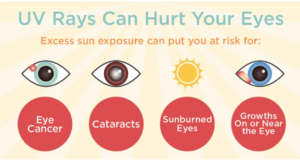
July ushers in the hottest, sunniest weeks of the year in the northern hemisphere. By mid-year, adults and youth who spend extended periods outdoors should be well aware of preventive practices to shield the eyes from UV solar radiation that can damage ocular surface tissues, as well as the cornea and lens. To emphasize the importance of shielding the eyes just as sunblock protects the skin, the American Academy of Ophthalmology (AAO) has designated July as UV Safety Month. This month, the AAO offers multiple eye safety tips that adults and youth can adopt to protect the eyes from UV-A and UV-B rays that can damage any exposed part of the body.
1) By far, the #1 preventive, eye-protecting practice that one can adopt during the months when the sun is brightest and most intense is to invest in UV-A and UV-B blocking sunglasses that block 99 to 100 percent of UV solar radiation. The AAO’s Tips for Choosing the Best Sunglasses page provides detailed information on what sunglass features to look for and what to ask an optician in choosing a UV ray-blocking protective pair.
UNC Optical Shop Manager Cyndi Wilkins, LDO, is among three licensed opticians at UNC Kittner Eye Center who stay busy helping UNC Ophthalmology patients, as well as walk-in non-patients, in choosing a pair of UV-blocking sunglasses from the multiple styles offered by the Optical Shop. Cyndi offers this guidance to those who are ready to move on from fashion sunglasses and invest in a pair of UV-A and UV-B blocking sunglasses to protect their eyes from the sun’s UV rays.
“At the Optical Shop, all three of us highly recommend polarized sunglasses, which come in several types. The best and most popular way is to purchase prescription sunglasses. The Optical Shop offers a range of prescription sunglasses: Maui Jm, Ray Ban, Wiley X and other designers like Kate Spade. We also have several types of fit-over sunglasses (ex: Cocoons), as well as sunglass clips that you place on top of your clear glasses. We encourage those with questions in advance of visiting to call the UNC Optical Shop direct line at UNC Kittner Eye Center at 984-974-2039.”
2) Sand and Shore — The sun’s damaging rays at the coast and other shorelines can cause the eyes to sunburn when UV rays reflect off sand and the water. Individuals spending prolonged periods at the beach or lakeside on sunny days should remember to wear UV-blocking protective eyewear along with their sunscreen.
3) Snow Blindness — Beyond year’s hottest months, prolonged exposure to UV rays reflected off ice and snow can cause “snow blindness,” which is characterized as temporary, but painful blindness over a period of hours. Snow skiers and snow boarders should be aware that high elevation as well as severe cold and dry weather increases risk of snow blindness.
Early detection is key to detecting and diagnosing damage to your eyes caused by prolonged sun exposure, and prevention is key to eye health and safety. Visit the AAO’s EyeSmart webpages for information developed by ophthalmologists on eye diseases and treatments, eye health news and tips for a lifetime of good eye health.
At any point year-round, schedule your comprehensive eye exam with UNC Ophthalmology by contacting at 984-974-2020.
@AcademyEyeSmart #UVSafetyMonth
